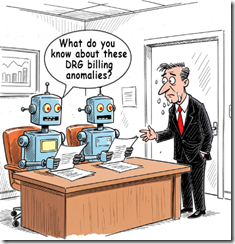Medical Fraud Meets AI. DRG Codes Meet AI. Enjoy
November 4, 2025
 This essay is the work of a dumb dinobaby. No smart software required.
This essay is the work of a dumb dinobaby. No smart software required.
I have heard that some large medical outfits make use of DRG “chains” or “coding sequences.” I picked up this information when my team and I worked on what is called a “subrogation project.” I am not going to explain how subrogation works or what the mechanisms operating are. These are back office or invisible services that accompany something that seems straightforward. One doesn’t buy stock from a financial advisor; there is plumbing and plumbing companies that do this work. The hospital sends you a bill; there is plumbing and plumbing companies providing systems and services. To sum up, a hospital bill is often large, confusing, opaque, and similar to a secret language. Mistakes happen, of course. But often inflated medical bills do more to benefit the institution and its professionals than the person with the bill in his or her hand. (If you run into me at an online fraud conference, I will explain how the “chain” of codes works. It is slick and not well understood by many of the professionals who care for the patient. It is a toss up whether Miami or Nashville is the Florence of medical fancy dancing. I won’t argue for either city, but I would add that Houston and LA should be in the running for the most creative center of certain activities.

“Grieving Family Uses AI Chatbot to Cut Hospital Bill from $195,000 to $33,000 — Family Says Claude Highlighted Duplicative Charges, Improper Coding, and Other Violations” contains some information that will be [a] good news for medical fraud investigators and [b] for some health care providers and individual medical specialists in their practices. The person with the big bill had to joust with the provider to get a detailed, line item breakdown of certain charges. Once that anti-social institution provider the detail, it was time for AI.
The write up says:
Claude [Anthropic, the AI outfit hooked up with Google] proved to be a dogged, forensic ally. The biggest catch was that it uncovered duplications in billing. It turns out that the hospital had billed for both a master procedure and all its components. That shaved off, in principle, around $100,000 in charges that would have been rejected by Medicare. “So the hospital had billed us for the master procedure and then again for every component of it,” wrote an exasperated nthmonkey. Furthermore, Claude unpicked the hospital’s improper use of inpatient vs emergency codes. Another big catch was an issue where ventilator services are billed on the same day as an emergency admission, a practice that would be considered a regulatory violation in some circumstances.
Claude, the smart software, clawed through the data. The smart software identified certain items that required closer inspection. The AI helped the human using Claude to get the health care provider to adjust the bill.
Why did the hospital make billing errors? Was it [a] intentional fraud programmed into the medical billing system; [b] was it an intentional chain of DRG codes tuned to bill as many items, actions, and services as possible within reason and applicable rules; or [c] a computer error. If you picked item c, you are correct. The write up says:
Once a satisfactory level of transparency was achieved (the hospital blamed ‘upgraded computers’), Claude AI stepped in and analyzed the standard charging codes that had been revealed.
Absolutely blame the problem on the technology people. Who issued the instructions to the technology people? Innocent MBAs and financial whiz kids who want to maximize their returns are not part of this story. Should they be? Of course not. Computer-related topics are for other people.
Stephen E Arnold, November 4, 2025
Google Is Really Cute: Push Your Content into the Jaws of Googzilla
November 4, 2025
 This essay is the work of a dumb dinobaby. No smart software required.
This essay is the work of a dumb dinobaby. No smart software required.
Google has a new, helpful, clever, and cute service just for everyone with a business Web site. “Google Labs’ Free New Experiment Creates AI-Generated Ads for Your Small Business” lays out the basics of Pomelli. (I think this word means knobs or handles.)

A Googley business process designed to extract money and data from certain customers. Thanks, Venice.ai. Good enough.
The cited article states:
Pomelli uses AI to create campaigns that are unique to your business; all you need to do is upload your business website to begin. Google says Pomelli uses your business URL to create a “Business DNA” that analyzes your website images to identify brand identity. The Business DNA profile includes tone of voice, color palettes, fonts, and pictures. Pomelli can also generate logos, taglines, and brand values.
Just imagine Google processing your Web site, its content, images, links, and entities like email addresses, phone numbers, etc. Then using its smart software to create an advertising campaign, ads, and suggestions for the amount of money you should / will / must spend via Google’s own advertising system. What a cute idea!
The write up points out:
Google says this feature eliminates the laborious process of brainstorming unique ad campaigns. If users have their own campaign ideas, they can enter them into Pomelli as a prompt. Finally, Pomelli will generate marketing assets for social media, websites, and advertisements. These assets can be edited, allowing users to change images, headers, fonts, color palettes, descriptions, and create a call to action.
How will those tireless search engine optimization consultants and Google certified ad reselling outfits react to this new and still “experimental” service? I am confident that [a] some will rationalize the wonderfulness of this service and sell advisory services about the automated replacement for marketing and creative agencies; [b] some will not understand that it is time to think about a substantive side gig because Google is automating basic business functions and plugging into the customer’s wallet with no pesky intermediary to shave off some bucks; and [c] others will watch as their own sales efforts become less and less productive and then go out of business because adaptation is hard.
Is Google’s idea original? No, Adobe has something called AI Found, according to the write up. Google is not into innovation. Need I remind you that Google advertising has some roots in the Yahoo garden in bins marked GoTo.com and Overture.com. Also, there is a bank account with some Google money from a settlement about certain intellectual property rights that Yahoo believed Google used as a source of business process inspiration.
As Google moves into automating hooks, it accrues several significant benefits which seem to stick up in Google’s push to help its users:
- Crawling costs may be reduced. The users will push content to Google. This may or may not be a significant factor, but the user who updates provides Google with timely information.
- The uploaded or pushed content can be piped into the Google AI system and used to inform the advertising and marketing confection Pomelli. Training data and ad prospects in one go.
- The automation of a core business function allows Google to penetrate more deeply into a business. What if that business uses Microsoft products? It strikes me that the Googlers will say, “Hey, switch to Google and you get advertising bonus bucks that can be used to reduce your overall costs.”
- The advertising process is a knob that Google can be used to pull the user and his cash directly into the Google business process automation scheme.
As I said, cute and also clever. We love you, Google. Keep on being Googley. Pull those users’ knobs, okay.
Stephen E Arnold, November 4, 2025
Don Quixote Takes on AI in Research Integrity Battle. A La Vista!
November 3, 2025
Scientific publisher Frontiers asserts its new AI platform is the key to making the most of valuable research data. ScienceDaily crows, “90% of Science is Lost. This New AI Just Found It.” Wow, 90%. Now who is hallucinating? Turns out that percentage only applies if one is looking at new research submitted within Frontiers’ new system. Cutting out past and outside research really narrows the perspective. The press release explains:
“Out of every 100 datasets produced, about 80 stay within the lab, 20 are shared but seldom reused, fewer than two meet FAIR standards, and only one typically leads to new findings. … To change this, [Frontiers’ FAIR² Data Management Service] is designed to make data both reusable and properly credited by combining all essential steps — curation, compliance checks, AI-ready formatting, peer review, an interactive portal, certification, and permanent hosting — into one seamless process. The goal is to ensure that today’s research investments translate into faster advances in health, sustainability, and technology. FAIR² builds on the FAIR principles (Findable, Accessible, Interoperable and Reusable) with an expanded open framework that guarantees every dataset is AI-compatible and ethically reusable by both humans and machines.”
That does sound like quite the time- and hassle- saver. And we cannot argue with making it easier to enact the FAIR principles. But the system will only achieve its lofty goals with wide buy-in from the academic community. Will Frontiers get it? The write-up describes what participating researchers can expect:
“Researchers who submit their data receive four integrated outputs: a certified Data Package, a peer-reviewed and citable Data Article, an Interactive Data Portal featuring visualizations and AI chat, and a FAIR² Certificate. Each element includes quality controls and clear summaries that make the data easier to understand for general users and more compatible across research disciplines.”
The publisher asserts its system ensures data preservation, validation, and accessibility while giving researchers proper recognition. The press release describes four example datasets created with the system as well as glowing reviews from select researchers. See the post for those details.
Cynthia Murrell, November 3, 2025
Hollywood Has to Learn to Love AI. You Too, Mr. Beast
October 31, 2025
 This essay is the work of a dumb dinobaby. No smart software required.
This essay is the work of a dumb dinobaby. No smart software required.
Russia’s leadership is good at talking, stalling, and doing what it wants. Is OpenAI copying this tactic? ”OpenAI Cracks Down on Sora 2 Deepfakes after Pressure from Bryan Cranston, SAG-AFTRA” reports:
OpenAI announced on Monday [October 20, 2025] in a joint statement that it will be working with Bryan Cranston, SAG-AFTRA, and other actor unions to protect against deepfakes on its artificial intelligence video creation app Sora.
Talking, stalling or “negotiating,” and then doing what it wants may be within the scope of this sentence.
The write up adds via a quote from OpenAI leadership:
“OpenAI is deeply committed to protecting performers from the misappropriation of their voice and likeness,” Altman said in a statement. “We were an early supporter of the NO FAKES Act when it was introduced last year, and will always stand behind the rights of performers.”
This sounds good. I am not sure it will impress teens as much as Mr. Altman’s posture on erotic chats, but the statement sounds good. If I knew Russian, it would be interesting to translate the statement. Then one could compare the statement with some of those emitted by the Kremlin.

Producing a big budget commercial film or a Mr. Beast-type video will look very different in 18 to 24 months. Thanks, Venice.ai. Good enough.
Several observations:
- Mr. Altman has to generate cash or the appearance of cash. At some point investors will become pushy. Pushy investors can be problematic.
- OpenAI’s approach to model behavior does not give me confidence that the company can figure out how to engineer guard rails and then enforce them. Young men and women fiddling with OpenAI can be quite ingenious.
- The BBC ran a news program with the news reader as a deep fake. What does this suggest about a Hollywood producer facing financial pressure working out a deal with an AI entrepreneur facing even greater financial pressure? I think it means that humanoids are expendable first a little bit and then for the entire digital production. Gamification will be too delicious.
Net net: I think I know how this interaction will play out. Sam Altman, the big name stars, and the AI outfits know. The lawyers know. Who doesn’t know? Frankly everyone knows how digital disintermediation works. Just ask a recent college grad with a degree in art history.
Stephen E Arnold, October 31, 2025
Will AMD Deal Make OpenAI Less Deal Crazed? Not a Chance
October 31, 2025
Why does this deal sound a bit like moving money from dad’s coin jar to mom’s spare change box? AP News reports, “OpenAI and Chipmaker AMD Sign Chip Supply Partnership for AI Infrastructure.” We learn AMD will supply OpenAI with hardware so cutting edge it won’t even hit the market until next year. The agreement will also allow OpenAI to buy up about 10% of AMD’s common stock. The day the partnership was announced, AMD’s shares went up almost 24%, while rival chipmaker Nvidia’s went down 1%. The write-up observes:
“The deal is a boost for Santa Clara, Calif.-based AMD, which has been left behind by rival Nvidia. But it also hints at OpenAI’s desire to diversify its supply chain away from Nvidia’s dominance. The AI boom has fueled demand for Nvidia’s graphics processing chips, sending its shares soaring and making it the world’s most valuable company. Last month, OpenAI and Nvidia announced a $100 billion partnership that will add at least 10 gigawatts of data center computing power. OpenAI and its partners have already installed hundreds of Nvidia’s GB200, a tall computing rack that contains dozens of specialized AI chips within it, at the flagship Stargate data center campus under construction in Abilene, Texas. Barclays analysts said in a note to investors Monday that OpenAI’s AMD deal is less about taking share away from Nvidia than it is a sign of how much computing is needed to meet AI demand.”
No doubt. We are sure OpenAI will buy up all the high-powered graphics chips it can get. But after it and other AI firms acquire their chips, will there be any left for regular consumers? If so, expect their costs to remain sky high. Just one more resource AI firms are devouring with little to no regard for the impact on others.
Cynthia Murrell, October 31, 2025
AI Will Kill, and People Will Grow Accustomed to That … Smile
October 30, 2025
 This essay is the work of a dumb dinobaby. No smart software required.
This essay is the work of a dumb dinobaby. No smart software required.
I spotted a story in SFGate, which I think was or is part of a dead tree newspaper. What struck me was the photograph (allegedly not a deep fake) of two people looking not just happy. I sensed a bit of self satisfaction and confidence. Regardless, both people gracing “Society Will Accept a Death Caused by a Robotaxi, Waymo Co-CEO Says.” Death, as far back as I can recall as an 81-year-old dinobaby, has never made me happy, but I just accepted the way life works. Part of me says that my vibrating waves will continue. I think Blaise Pascal suggested that one should believe in God because what’s the downside. Go, Blaise, a guy who did not get to experience an an accident involving a self-driving smart vehicle.

A traffic jam in a major metro area. The cause? A self-driving smart vehicle struck a school bus. But everyone is accustomed to this type of trivial problem. Thanks, MidJourney. Good enough like some high-tech outfits’ smart software.
But Waymo is a Google confection dating from 2010 if my memory is on the money. Google is a reasonably big company. It brokers, sells, and creates a market for its online advertising business. The cash spun from that revolving door is used to fund great ideas and moon shots. Messrs. Brin, Page, and assorted wizards had some time to kill as they sat in their automobiles creeping up and down Highway 101. The idea of a self-driving car that would allow a very intelligent, multi-tasking driver to do something productive than become a semi-sentient meat blob sparked an idea. We can rig a car to creep along Highway 101. Cool. That insight spawned what is now known as Waymo.
An estimable Google Waymo expert found himself involved in litigation related to Google’s intellectual property. I had ignored Waymo until the Anthony Levandowski founded a company, sold it to Uber, and then ended up in a legal matter that last from 2017 to 2019. Publicity, I have heard, whether positive or negative, is good. I knew about Waymo: A Google project, intellectual property, and litigation. Way to go, Waymo.
For me, Waymo appears in some social media posts (allegedly actual factual) when Waymo vehicles get trapped in a dead end in Cow Town. Sometimes the Waymos don’t get out of the way of traffic barriers and sit purring and beeping. I have heard that some residents of San Francisco have [a] kicked, [b] sprayed graffiti on Waymos, and/or [c] put traffic cones in certain roads to befuddle the smart Google software-powered vehicles. From a distance, these look a bit like something from a Mad Max motion picture.
My personal view is that I would never stand in front of a rolling Waymo. I know that [a] Google search results are not particularly useful, [b] Google’s AI outputs crazy information like glue cheese on pizza, and [c] Waymo’s have been involved in traffic incidents which cause me to stay away from Waymos.
The cited article says that the Googler said in response to a question about a Waymo hypothetical killing of a person:
“I think that society will,” Mawakana answered, slowly, before positioning the question as an industry wide issue. “I think the challenge for us is making sure that society has a high enough bar on safety that companies are held to.” She said that companies should be transparent about their records by publishing data about how many crashes they’re involved in, and she pointed to the “hub” of safety information on Waymo’s website. Self-driving cars will dramatically reduce crashes, Mawakana said, but not by 100%: “We have to be in this open and honest dialogue about the fact that we know it’s not perfection.” [Emphasis added by Beyond Search]
My reactions to this allegedly true and accurate statement from a Googler are:
- I am not confident that Google can be “transparent.” Google, according to one US court is a monopoly. Google has been fined by the European Union for saying one thing and doing another. The only reason I know about these court decisions is because legal processes released information. Google did not provide the information as part of its commitment to transparency.
- Waymos create problems because the Google smart software cannot handle the demands of driving in the real world. The software is good enough, but not good enough to figure out dead ends, actions by human drivers, and potentially dangerous situations. I am aware of fender benders and collisions with fixed objects that have surfaced in Waymo’s 15 year history.
- Self driving cars specifically Waymo will injure or kill people. But Waymo cars are safe. So some level of killing humans is okay with Google, regulators, and the society in general. What about the family of the person who is killed by good enough Google software? The answer: The lawyers will blame something other than Google. Then fight in court because Google has oodles of cash from its estimable online advertising business.
The cited article quotes the Waymo Googler as saying:
“If you are not being transparent, then it is my view that you are not doing what is necessary in order to actually earn the right to make the roads safer,” Mawakana said. [Emphasis added by Beyond Search]
Of course, I believe everything Google says. Why not believe that Waymos will make self driving vehicle caused deaths acceptable? Why not believe Google is transparent? Why not believe that Google will make roads safer? Why not?
But I like the idea that people will accept an AI vehicle killing people. Stuff happens, right?
Stephen E Arnold, October 30, 2025
The Good Old Days of Mainframes? Is Vibe the Answer?
October 29, 2025
 This essay is the work of a dumb dinobaby. No smart software required.
This essay is the work of a dumb dinobaby. No smart software required.
I like mainframe stories. I read a very good one titled “That Time I Trashed The Company Mainframe, And The Lesson I Learned.” The incident took place decades ago. The main idea is that a young programmer wrote an innocuous program, stuffed it in a mainframe, and generated instant chaos. The lesson for the young programmer was to check and double check one’s code. Easy to say.
There were several gems in the write up. I want to highlight these.

The future is in the hands of smart software. Thanks, Venice AI. Good enough.
First, there is a reference to the programming required for the F-16. Keep in mind that these aircraft are still operational today. The aircraft entered service in the early 1980s. Yep, mainframe code. What does that tell you about fixing up software for some F-16s? Some special knowledge is going to be required. This information is not routinely presented in university computer science courses. My mainframe wizard is darned old and not too peppy. Just whip out your iPhone and bang out some Rust. You can get the F-16 up to speed in no time.
Second, a number of product names appear in the essay. These include:
- Fortran, yep just like JavaScript
- Zilog 8000, a definite fave in electrical engineering courses today
- Job Control Language, easy peasy.
What’s interesting is that I believe that many major systems today are still in daily use.
Third, the write up captures the approach that made those who worked in data centers so darned popular. Emily Post’s mom approved of this behavior:
In 1982, we had no email (executives did, but no one else); therefore, we all had a phone as our primary communication device. When I picked up the phone, all I heard was a lot of swear words and yelling. The IBM mainframe operator was screaming at me for submitting a job that caused his operator console to overflow with errors. He was acting as if I had trashed the entire mainframe and made his life a living hell.
Would some of the young data snowflakes melt with this professional exchange. Gee, of course not. Just head to a Googley relaxation pod and chill. You hope.
I wish to quote form the wrap up of the cited article:
That is the lesson I learned here: reading source code is essential, and I could actually understand a codebase I had never seen before. Confidence-building things like this really helped me move forward in becoming a more professional programmer.
Just keep in mind that smart software is going to do this type of job in the future. There will be absolutely no problems. I am confident that experienced humans will fail their automated hiring tests administered by a tailored large language model. A perfect world with perfect software is arriving.
Stephen E Arnold, October 29, 2025
Think It and the It May Not Happen. Right, OpenAI?
October 29, 2025
The collaboration that was meant to revolutionize how humans interact with technology has hit some snags. Coming up with another iPhone-level idea is tough, it seems. Ars Technica reports, “OpenAI, Jony Ive Struggle with Technical Details on Secretive New AI Gadget.” While he was at Apple, Ive designed some of that company’s most iconic products. When OpenAI bought his startup for $6.5 billion in May, Altman and Ive promised a radical new AI assistant that would eclipse Amazon’s Alexa and Google Assistant: a palm-sized, screenless device that would incorporate real-world context and adapt to each user’s needs.
In order to achieve this grand vision, OpenAI hired at least a dozen Apple device experts on top of the 20-some former Apple employees at Ive’s startup. We are told it also poached some workers from Meta’s Quest headset and smart glasses projects. However, that pool of considerable talent has not ensured smooth sailing. We learn:
“Despite having hardware developed by Ive and his team—whose alluring designs of the iMac, iPod, and iPhone helped turn Apple into one of the most valuable companies in the world—obstacles remain in the device’s software and the infrastructure needed to power it. These include deciding on the assistant’s ‘personality,’ privacy issues, and budgeting for the computing power needed to run OpenAI’s models on a mass consumer device.”
Ah yes, computing power. The reason data centers are springing up like thirsty weeds across the land. While Amazon and Google have plenty of compute to power their assistants, we learn, OpenAI has some catching up to do. As for those privacy issues, the write-up does not elaborate. We would be curious to know those details.
Then there is the issue of the virtual aide’s personality. The write-up tells us:
“Two people familiar with the project said that settling on the device’s ‘voice’ and its mannerisms were a challenge. One issue is ensuring the device only chimes in when useful, preventing it from talking too much or not knowing when to finish the conversation—an ongoing issue with ChatGPT. ‘The concept is that you should have a friend who’s a computer who isn’t your weird AI girlfriend… like [Apple’s digital voice assistant] Siri but better,’ said one person who was briefed on the plans. OpenAI was looking for ‘ways for it to be accessible but not intrusive.’ ‘Model personality is a hard thing to balance,’ said another person close to the project. ‘It can’t be too sycophantic, not too direct, helpful, but doesn’t keep talking in a feedback loop.’”
Yes, one would not want to annoy the end user with cyclic conversations. Or a “weird AI girlfriend.” (By the way, have we given up hope on default male or gender-neutral AI voices? Just wondering.) The article notes a couple devices that sound similar to Altman and Ive’s vision have not fared well. Humane, a firm funded in part by Altman personally, has ditched its AI pin. Meanwhile, the Friend AI necklace has been widely reviled. Will the Apple vets (eventually) succeed where others have failed? But in OpenAI Land the “Sky” is the limit. He, just buy stuff. That sometimes is easier.
Cynthia Murrell, October 29, 2025
Okay Business Strategy Experts: What Now for AI Innovation?
October 29, 2025
As AI forces its way into our lives, it requires us to shift our thinking in several areas. On his Substack, Charlie Graham examines how AI may render a key software strategy obsolete. He declares, “’Be Different’ Doesn’t Work for Building Products Anymore.” Personally, we believe coming up with something lots of people want or something rich people must absolutely have is the key to success. But it is also a wise develop something to distinguish oneself from the competition. Or, at least, it was. Now that approach may be wasted effort. Graham writes:
“In the past, the best practice to win in a competitive market was to differentiate yourself – ‘be different,’ as Steve Jobs would say. But product differentiation is no longer effective in this new world.
- Differentiate on an amazing UX? You used to rely on your awesome UX team for a sustainable advantage. Now, dozens of competitors can screenshot (or soon video) your flow and give it to an AI to reproduce quickly.
- Differentiate by excelling at one feature? You might get a temporary lead, but it’s now pretty trivial for competitors to get close to your functionality.
- Differentiate on business model? If it starts working, dozens of your recently started competitors will vibe-code a switch over.
- Differentiate on ‘proprietary data’? This isn’t the key differentiator it was expected to be, as we are finding data can be simulated or companies can find similar-enough data to get 80% of the way there.
Instead we live in a red ocean where features are copied in days or weeks and everyone is fighting with similar products for the same scraps. So what does work?”
The post proposes several answers to that question. For example, those with large, proprietary distribution networks still have an advantage. Also, obscure, complex niches come with fewer competitors. So does taking on difficult or expensive product integrations. On the darker side, one could guard against customer loss by compounding data lock-in, making migration away as painful as possible. Then there is networking– a consistent necessity; social media and online marketplaces now fill that need. See the post for details on each of these points. What other truisms will AI force us to reconsider?
Cynthia Murrell, October 29, 2025
Google and Anthropic: Sharing a Sleeping Bag. Will They Get Married?
October 28, 2025
 This essay is the work of a dumb dinobaby. No smart software required.
This essay is the work of a dumb dinobaby. No smart software required.
“Anthropic to Use 1 Million Google TPUs” contains a couple of interesting allegedly true factoids. The hook for the story is that Google has worked out a deal for Anthropic to use a few of Google’s smart processors. According to the Analytics India article:
The expansion is valued at ‘tens of billions of dollars,’ with an expected capacity of over a gigawatt coming online in 2026.
The numbers are the first thing that caught my attention. One million chips. Tens of billions. A gigawatt of power. I worked at Halliburton Nuclear years ago. If I remember what one of the Couchmans (either Don or Mel) told me. A gigawatt would could power about one million homes simultaneously. Think in terms of San Jose which has about a million residents I think.

Thanks, MidJourney. Good enough.
Second, I noted this statement:
The company [Anthropic] reported serving over 300,000 business customers, and the number of large accounts—those generating more than $100,000 in annual revenue—has increased nearly sevenfold in the past year.
The numbers are smaller. 300,000 business customers. What’s a business customer? Not defined. Dun & Bradstreet and other company tracking services split businesses up by revenue, their business sector, and other slices. Okay, 300,000. The estimable US Small Business Administration has kicked out a number of 36 million businesses in the US. (Is this number correct? What? You are doubting the US government data? Incredible.) The point is that Anthropic has 0.9375% of this SBA number of businesses. Now let’s assume that Anthropic gets four times its 300,000 business users in the next two years. That means Anthropic’s power demands for 1.2 million business users means that it will require the electrical generation capacity of Los Angeles. No big deal, right? The only hitch in the git along is that Anthropic-type growth could move more quickly than the folks who have to build, expand, or invent new energy sources. You see the problem. Big numbers don’t match the reality of power availability.
But Anthropic and Google are in one of those circular deals. Google invests in Anthropic; Anthropic buys a few processors. Analytics India says:
Google has been involved in various funding efforts for Anthropic, and a report from The New York Times earlier this year stated that it owns 14% of Anthropic, citing legal findings.
Several observations:
- This AI sector is into really big numbers. Most people cannot think about really big numbers. Most people think about a $300 property tax bill or paying for groceries at the price leader. (Did you think Whole Foods or Kroger?)
- The diffusion of AI to a tiny percentage of US businesses has a fairly hefty need for power, chips, and assorted infrastructure. That’s good for those in that business.
- The power generation shortfall is a bit of pothole, a deep pothole.
So what? Just Anthropic will require power equivalent to keeping the lights on in four LAs or one Istanbul.
Do you see a problem? I don’t because I believe that magical Google and Anthropic can solve any problem.
A rough calculation is that a human brain consumes 0.000002% of a gigawatt in 24 hours. That’s efficient. But I have confidence in Google and Anthropic. No problem is too big or complex for these bright, energetic professionals.
Stephen E Arnold, October 28, 2025


